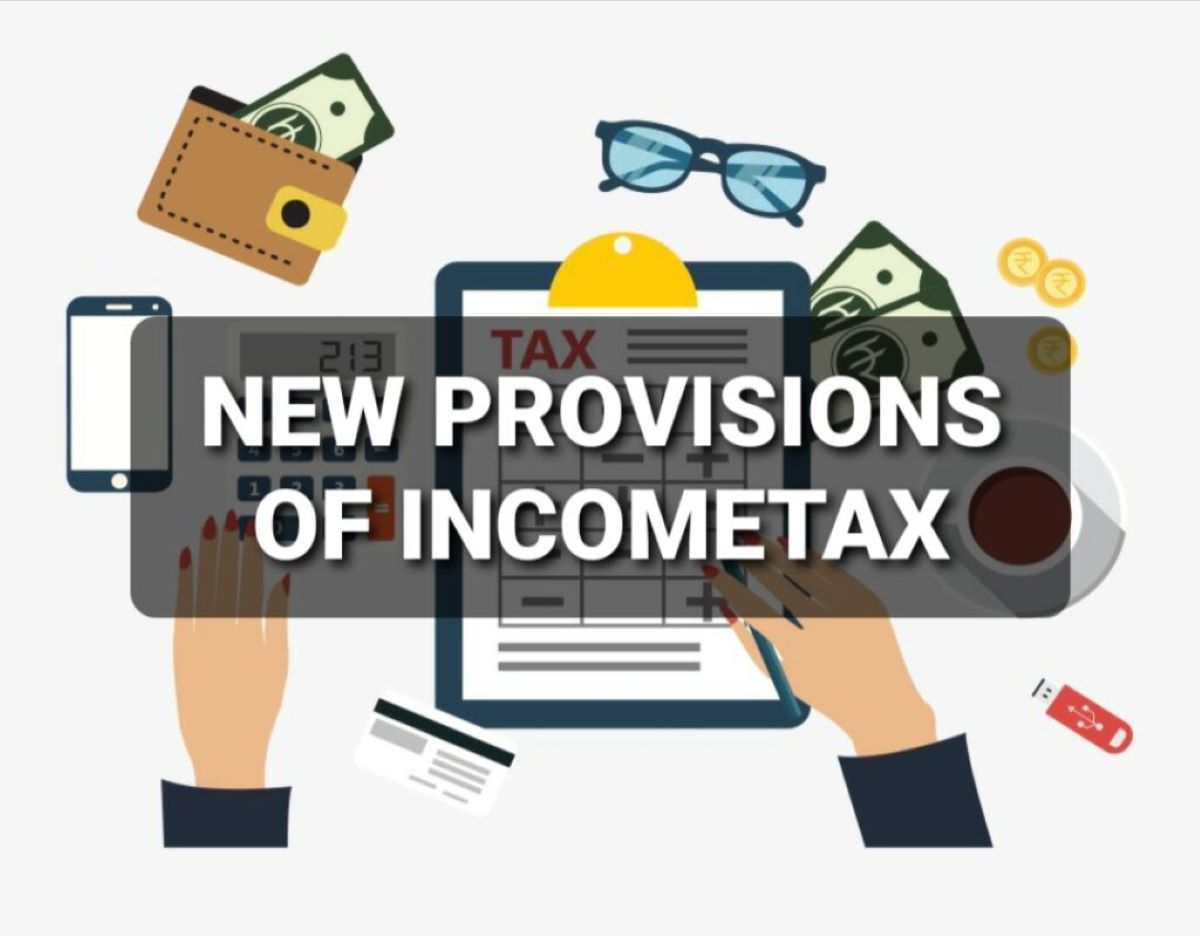

Finance
How Does Hedging Decrease Future Income Tax
Published: January 15, 2024
Find out how implementing hedging strategies can help decrease future income tax and optimize your finances. Explore finance tips and expertise from our experts.
(Many of the links in this article redirect to a specific reviewed product. Your purchase of these products through affiliate links helps to generate commission for LiveWell, at no extra cost. Learn more)
Table of Contents
- Introduction
- What is Hedging?
- The Role of Hedging in Reducing Income Tax
- Types of Hedging Strategies
- Case Studies on the Impact of Hedging on Future Income Tax
- Potential Risks and Limitations of Hedging for Decreasing Income Tax
- Comparison of Hedging with Other Tax Reduction Strategies
- Considerations for Implementing Hedging in Tax Planning
- Conclusion
Introduction
Income tax is a complex and often burdensome obligation for individuals and businesses. It can significantly impact financial planning and the overall profitability of a venture. Fortunately, there are various strategies available to minimize income tax liabilities, one of which is hedging. Hedging is a financial practice that involves taking positions in derivative contracts to offset potential losses or gains in an underlying asset.
In this article, we will explore how hedging can be utilized as a tool to decrease future income tax. We will examine the different types of hedging strategies, analyze case studies that highlight the impact of hedging on tax reduction, discuss the risks and limitations associated with hedging, and compare hedging with other tax reduction strategies. Finally, we will provide considerations for implementing hedging in tax planning.
Hedging has long been employed by businesses and investors as a risk management strategy. By using financial instruments such as futures, options, and swaps, entities can mitigate the impact of price fluctuations, interest rate changes, and foreign exchange rate movements. However, hedging can also have an indirect effect on income tax liabilities.
While the primary purpose of hedging is not tax reduction, it can inadvertently lead to favorable tax outcomes. By creating a hedge position that effectively offsets gains or losses in an underlying asset, businesses can potentially reduce their taxable income. This is achieved by deducting losses or deferring gains to future tax periods.
It is important to note that hedging should not be viewed solely as a tax-saving mechanism. The decision to hedge should be driven by the need to manage risk and protect the financial interests of the entity. Tax considerations should be integrated into the overall hedging strategy to optimize tax outcomes while maintaining a balanced approach.
In the following sections, we will delve deeper into the different hedging strategies, explore real-world examples that illustrate the impact of hedging on future income tax, and discuss the potential risks and limitations associated with this approach. We will also compare hedging with other tax reduction strategies to provide a holistic view of its efficacy. Finally, we will highlight key considerations for implementing hedging in tax planning.
What is Hedging?
Hedging is a risk management strategy that involves taking offsetting positions in derivative contracts to reduce the potential impact of adverse price movements or fluctuations in the value of an underlying asset. It is commonly used by businesses and investors to protect against potential losses and stabilize financial outcomes.
At its core, hedging aims to reduce uncertainty and manage risk by establishing a hedge position that counterbalances the exposure to a particular asset or financial instrument. This is accomplished by creating a trading position in derivatives that is inversely correlated to the value or performance of the underlying asset.
Derivative contracts, such as futures, options, and swaps, are financial instruments that derive their value from an underlying asset or benchmark. When implemented strategically, these derivatives can help mitigate the impact of unfavorable price movements in various markets, including commodities, currencies, interest rates, and equities.
For example, let’s consider a scenario where a business is highly dependent on the price of oil as a critical input for its operations. Fluctuations in oil prices can have a significant impact on the profitability of the business. To mitigate this risk, the business can enter into a futures contract to sell a certain amount of oil at a predetermined price in the future. This hedge position acts as insurance against potential losses if the price of oil decreases.
On the other hand, if the business is concerned about the price of oil increasing, it can enter into a futures contract to buy oil at a predetermined price. This hedge position protects the business from potential higher costs of purchasing oil in the future.
Hedging can also be applied to manage currency risk. For instance, businesses engaged in international trade may face exposure to fluctuations in exchange rates. By entering into currency derivative contracts, such as forward contracts or currency options, they can protect themselves against adverse currency movements and secure predictable cash flows.
It is important to note that hedging does not eliminate risk entirely. It aims to reduce exposure to adverse price movements, but it can also limit potential gains if the market moves in a favorable direction. The goal is to strike a balance between protecting against losses and capitalizing on favorable market conditions.
Overall, hedging is a strategic financial tool that allows businesses and investors to manage risk and uncertainty. By employing derivative instruments to offset potential losses or gains in an underlying asset, hedging provides a measure of stability and predictability in an ever-changing market environment.
The Role of Hedging in Reducing Income Tax
While the primary purpose of hedging is to manage risk and protect financial interests, it can also play a significant role in reducing income tax liabilities. By strategically utilizing hedging strategies, businesses can potentially deduct losses or defer gains, resulting in lower taxable income.
One way hedging can reduce income tax is through the treatment of hedging losses. When a business has a hedging position that offsets a loss in the value of an underlying asset, it can typically deduct the hedging losses against its taxable income. This deduction can help offset any gains or income generated in other areas of the business, effectively lowering the taxable income and reducing the overall tax liability.
Additionally, hedging can allow businesses to defer the recognition of certain gains. For example, if a business enters into a futures contract to lock in a favorable price for a commodity it intends to sell in the future, any gains from the sale of the commodity may be deferred until the contract expires or is settled. By deferring the recognition of these gains to a later tax period, businesses can potentially benefit from lower tax rates or utilize other tax planning strategies to further optimize their tax position.
Another way hedging can reduce income tax is by managing the timing of income recognition. By using derivative contracts, businesses can shift the recognition of income from one tax period to another, effectively aligning it with more favorable tax rates or taking advantage of specific provisions or incentives available in a particular year. This strategic income timing can result in immediate tax savings or provide opportunities for tax planning and optimization.
Furthermore, hedging can impact the calculation of taxable income for businesses that operate in multiple currencies. Fluctuations in exchange rates can have significant implications for income tax liabilities, especially when it comes to translating foreign currency assets, liabilities, and income. Through the use of currency hedging strategies, businesses can mitigate these tax exposures and potentially decrease their overall income tax obligations.
It is worth noting that the tax treatment of hedging transactions can vary depending on the jurisdiction and applicable tax laws. Businesses should consult with tax professionals and advisors to ensure compliance with the specific rules and regulations governing their particular circumstances.
Overall, hedging can be a valuable tool in reducing income tax liabilities. By strategically utilizing hedging strategies, businesses can deduct losses, defer gains, manage income timing, and mitigate currency-related tax exposures. However, it is important to integrate tax considerations into the overall hedging strategy while maintaining a risk management focus to optimize tax outcomes and ensure compliance with applicable tax laws.
Types of Hedging Strategies
Hedging strategies can take many forms, depending on the nature of the underlying asset or risk being managed. Here are some common types of hedging strategies:
- Futures Contracts: Futures contracts are one of the most widely used hedging instruments. They allow businesses to lock in a future price for a particular asset, such as commodities, currencies, or interest rates. By taking a position in a futures contract, a business can protect against potential price fluctuations and mitigate the risk of adverse market movements.
- Options Contracts: Options contracts provide the holder with the right, but not the obligation, to buy or sell an asset at a predetermined price within a specified time frame. Call options allow businesses to purchase the underlying asset, while put options allow businesses to sell the asset. Options can be utilized to hedge against both upward and downward price movements, providing flexibility in managing risk.
- Forward Contracts: Similar to futures contracts, forward contracts allow businesses to enter into an agreement to buy or sell an asset at a predetermined price in the future. However, forward contracts are typically customized to meet specific needs and are traded over-the-counter rather than on organized exchanges. They can be used to hedge against potential price fluctuations, particularly in the context of foreign exchange or commodity markets.
- Swaps: Swaps involve the exchange of cash flows or other risks between two parties. Common types of swaps include interest rate swaps, currency swaps, and commodity swaps. Swaps can be utilized to hedge against potential changes in interest rates, exchange rates, or commodity prices. By entering into a swap agreement, businesses can effectively manage their exposure to these risks.
- Natural Hedges: Natural hedges arise when a business has inherent offsets within its operations or assets. For example, a business with both foreign currency revenues and expenses can naturally hedge its currency risk. If the currency appreciates, the gain in revenue can offset the increase in expenses, mitigating the overall impact on profitability. Natural hedges require careful analysis of the business’s operations and assets to identify and leverage these inherent offsets.
It is important to note that hedging strategies should be tailored to the specific needs and risk exposures of the business. The choice of hedging instrument and approach will depend on factors such as the underlying asset, market conditions, regulatory environment, and the business’s risk tolerance.
Moreover, effective implementation of hedging strategies requires a thorough understanding of the risks involved, as well as careful monitoring and management of the hedge positions. Regular review and adjustment of hedges may be necessary to ensure they are aligned with changing market conditions and business objectives.
By utilizing these various hedging strategies, businesses can effectively mitigate risk, protect against adverse market movements, and enhance their overall financial stability.
Case Studies on the Impact of Hedging on Future Income Tax
Examining real-world case studies provides valuable insights into the impact of hedging on future income tax. These examples demonstrate how strategic hedging can effectively reduce tax liabilities and optimize tax outcomes for businesses.
Case Study 1: Commodity Hedging
A manufacturing company relies heavily on a specific commodity as a key raw material. Fluctuations in the price of the commodity can have a significant impact on the company’s profitability. To mitigate this risk, the company enters into futures contracts to lock in the purchase price of the commodity for a specific period.
As a result of the hedging strategy, the company is able to reduce its tax liability in two ways. Firstly, if the commodity price increases, the hedging losses are deductible against taxable income, thus offsetting the profit impact. Secondly, by deferring the recognition of gains on the sale of finished goods until the expiration of the futures contracts, the company is able to strategically time the recognition of income, potentially taking advantage of lower tax rates in the future.
Case Study 2: Foreign Currency Hedging
An international e-commerce company operates in various countries and generates revenue in multiple currencies. Fluctuations in exchange rates present significant risk to its profitability. To manage this risk, the company utilizes currency forward contracts to hedge its foreign currency exposure.
Through strategic currency hedging, the company is able to reduce its income tax liabilities by aligning income recognition with advantageous tax rates. If a particular currency depreciates, the losses realized on the currency hedges can be used to offset taxable income in that jurisdiction. Furthermore, by deferring the recognition of gains on foreign currency transactions until the settlement of the hedges, the company has the flexibility to optimize its tax position based on prevailing tax regulations.
Case Study 3: Interest Rate Hedging
A real estate development company obtains financing through variable-rate loans. Interest rate fluctuations pose a significant risk to the company’s financial stability. To mitigate this risk, the company enters into interest rate swap agreements, converting its variable-rate debt into fixed-rate debt.
The interest rate hedging strategy not only stabilizes the company’s financial position but also has a positive impact on its income tax liabilities. By locking in fixed interest rates through the swap agreements, the company can accurately predict interest expenses, which can be deducted against taxable income. This reduces the company’s tax liability and provides financial certainty in planning future cash flows.
These case studies illustrate how hedging strategies can effectively reduce income tax liabilities for businesses. However, it is crucial to note that the tax treatment may vary based on jurisdiction and specific circumstances. Consulting with tax professionals is essential to ensure compliance with applicable tax laws and to optimize the tax benefits of hedging strategies.
Potential Risks and Limitations of Hedging for Decreasing Income Tax
While hedging can be an effective strategy for decreasing income tax liabilities, it is important to be aware of the potential risks and limitations associated with this approach. Understanding these factors will help businesses make informed decisions and mitigate any adverse consequences.
1. Market Risk: Hedging involves taking positions in derivative contracts that are designed to offset potential losses in the underlying asset. However, if the market moves in a direction opposite to the anticipated position, the hedging strategy may not be as effective, and losses may be incurred. Businesses need to carefully assess the risks involved and regularly monitor and adjust their hedging positions to manage market volatility.
2. Compliance and Accounting Complexity: Hedging transactions can have complex accounting implications, requiring businesses to comply with specific reporting standards. Accurate record-keeping and timely documentation are essential to ensure compliance with accounting regulations and tax laws. It is important to work closely with tax advisors and accounting professionals to ensure proper implementation and accurate reporting of hedging transactions.
3. Unforeseen Costs: Engaging in hedging strategies may involve additional costs, such as transaction fees, margin requirements, or the need to pay premiums for options contracts. Businesses should carefully evaluate the costs versus the potential benefits to determine if the hedging strategy is financially viable and aligns with their risk management and tax objectives.
4. Liquidity and Counterparty Risk: Hedging strategies often involve entering into agreements with counterparties, such as banks or financial institutions. Businesses should assess the creditworthiness and reliability of counterparties to mitigate the risk of default or inability to fulfill contractual obligations. Liquidity risk should also be considered, as some derivative markets may have limited liquidity, making it challenging to exit or adjust positions in times of market stress.
5. Regulatory and Tax Changes: Tax laws and regulations are subject to change, and new regulations or interpretations may impact the tax treatment of hedging transactions. Businesses should remain vigilant and keep abreast of any updates to ensure ongoing compliance and assess the continued effectiveness of their hedging strategies for tax reduction purposes.
6. Effectiveness of Hedging Strategies: The effectiveness of hedging strategies in reducing income tax liabilities can vary depending on market conditions, the complexity of the hedging instruments used, and the specific circumstances of the business. It is crucial to carefully evaluate the potential tax benefits in relation to the costs and risks associated with the chosen hedging strategies.
By understanding and mitigating these risks and limitations, businesses can navigate through the complexities of hedging for decreasing income tax. Careful planning, regular monitoring, and engagement with experienced professionals are essential to ensure the successful implementation of hedging strategies and the optimization of tax outcomes.
Comparison of Hedging with Other Tax Reduction Strategies
When it comes to reducing income tax liabilities, businesses have various strategies at their disposal. It is important to compare hedging with other tax reduction strategies to determine which approach is most suitable for specific circumstances and objectives. Here, we examine some common tax reduction strategies and their key differences compared to hedging.
1. Tax Credits and Incentives: Tax credits and incentives are provided by governments to encourage certain behaviors or investments. They can include research and development (R&D) tax credits, investment tax credits, or tax incentives for job creation or environmental initiatives. Unlike hedging, which focuses on managing risk, tax credits and incentives directly reduce tax liabilities by providing credits or deductions against taxable income. However, eligibility criteria and requirements must be met to qualify for these incentives.
2. Capital Expenditure Planning: By strategically planning capital expenditures, businesses can optimize tax deductions through depreciation or immediate expensing of assets. This can help reduce taxable income and lower overall tax liabilities. Unlike hedging, capital expenditure planning involves making deliberate decisions about asset investments and timing to maximize tax benefits.
3. Structuring and Entity Selection: Businesses may adopt specific legal structures or entity types to minimize income taxes. For example, forming a Limited Liability Company (LLC) or incorporating as an S Corporation may offer certain tax advantages. This approach is different from hedging in that it focuses on structuring and organizing the business entity to optimize tax outcomes rather than directly managing risk or reducing tax liabilities through financial instruments.
4. Tax Loss Harvesting: Tax loss harvesting involves strategically selling investments that have decreased in value to offset taxable gains. This allows businesses to reduce their overall tax liability by utilizing capital losses. Unlike hedging, tax loss harvesting involves actively managing investment portfolios and taking advantage of market fluctuations to optimize tax outcomes.
5. Transfer Pricing: Transfer pricing refers to the setting of prices for transactions between related entities within a multinational corporation. By establishing arm’s length pricing for intercompany transactions, businesses can allocate profits to low-tax jurisdictions and reduce overall tax liabilities. Transfer pricing is a complex area of tax planning that focuses on the pricing of transactions rather than managing risk through financial instruments like hedging.
While these strategies differ from hedging in their approach and focus, they can be complementary and used in combination to optimize tax outcomes. The choice of strategy depends on the specific goals, risk tolerance, and circumstances of the business. It is vital to consult with tax professionals and advisors who can provide tailored advice and guidance.
Ultimately, hedging offers a unique advantage by simultaneously managing risk and potentially reducing income tax liabilities. It allows businesses to protect against adverse market movements while strategically timing income recognition and deducting losses. When integrated with other tax reduction strategies, hedging can enhance the overall tax planning approach and contribute to long-term financial stability.
Considerations for Implementing Hedging in Tax Planning
Implementing hedging as part of tax planning requires careful consideration of various factors. By keeping the following key considerations in mind, businesses can effectively integrate hedging strategies into their overall tax planning approach:
1. Risk and Volatility Assessment: Conduct a thorough assessment of the risks and volatility associated with the underlying assets that need to be hedged. Evaluate the potential impact of price fluctuations, interest rate changes, or currency movements on the business’s profitability. This assessment will help determine the suitable hedging instruments and strategies to mitigate these risks.
2. Tax Implications: Understand the tax implications of hedging transactions in the relevant jurisdiction. Different countries may have specific tax rules and regulations governing hedging instruments and their treatment for tax purposes. Engage tax professionals to ensure compliance with these regulations and to optimize the tax outcomes of hedging activities.
3. Documentation and Record-Keeping: Establish proper documentation and record-keeping processes for hedging transactions. Ensure that all relevant agreements, contracts, and supporting documents are accurately maintained. This documentation will not only assist in tax compliance but also help in monitoring the effectiveness and performance of hedging positions.
4. Accounting Standards and Reporting: Understand the accounting standards and reporting requirements associated with hedging transactions. Implement appropriate accounting processes to ensure accurate recording and reporting of hedging activities in financial statements. Adhering to accounting standards will support transparency and compliance in tax reporting.
5. Monitoring and Adjustments: Regularly monitor and assess the performance and effectiveness of hedging positions. Market conditions can change, requiring adjustments to hedging strategies. Review and analyze the impact of hedging on overall tax planning and adjust positions as needed to align with changing business objectives and market dynamics.
6. Professional Advice: Engage experienced tax advisors, legal professionals, and financial experts who specialize in hedging and tax planning. Their expertise can provide valuable guidance on selecting the most appropriate hedging instruments, optimizing tax outcomes, and ensuring compliance with relevant tax laws and regulations.
7. Risk Management Over Tax Saving: Prioritize risk management objectives over tax savings. While hedging can provide tax benefits, it should not compromise the primary purpose of managing risk and protecting the business’s financial stability. Ensure that hedging strategies align with the overall financial and risk management goals of the business.
8. Ongoing Evaluation: Regularly evaluate the performance and effectiveness of hedging strategies in achieving tax reduction objectives. Monitor changes in tax laws and regulations that may impact the tax treatment of hedging transactions. Continuously assess the alignment between hedging activities and overall tax planning to ensure optimal outcomes.
By considering these factors and seeking professional advice, businesses can effectively incorporate hedging strategies into their tax planning initiatives. Adopting a comprehensive and proactive approach will help maximize the benefits of hedging while minimizing potential risks and ensuring compliance with applicable tax laws and regulations.
Conclusion
Hedging can be a powerful tool in reducing future income tax liabilities for businesses. By strategically employing various hedging strategies, businesses can mitigate risk, manage uncertainty, and optimize their tax outcomes. Whether through commodity hedging, foreign currency hedging, interest rate hedging, or other forms of risk management, hedging offers businesses the ability to potentially deduct losses, defer gains, manage income timing, and mitigate tax exposures.
However, it is important to recognize that hedging is just one element of an effective tax reduction strategy. It should be integrated with other tax planning approaches and considerations to maximize its benefits. Combining hedging with tax credits and incentives, capital expenditure planning, entity structuring, and other strategies can create a well-rounded and comprehensive tax plan that is customized to meet the unique needs and goals of the business.
Implementing hedging in tax planning requires careful assessment of risks, understanding of tax implications, proper documentation, and ongoing monitoring and adjustment. Collaborating with tax professionals and advisors is crucial to navigate the complexities, ensure compliance with tax regulations, and optimize the tax benefits of hedging activities.
In conclusion, hedging offers businesses the opportunity to not only manage risk but also reduce income tax liabilities. By strategically employing hedging strategies while considering the limitations and risks associated with them, businesses can gain financial stability, protect profitability, and optimize their tax outcomes in a dynamic and ever-changing market environment.
Ultimately, the success of a hedging strategy lies in its integration with a comprehensive tax plan that is aligned with the objectives of the business. With careful planning, diligent execution, and professional guidance, businesses can harness the power of hedging to decrease future income tax and create a solid financial foundation for long-term success.














